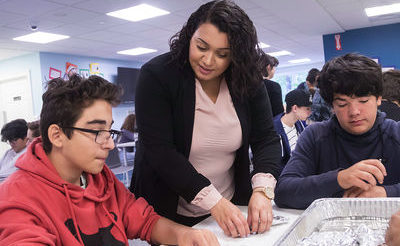Innovation Is Everywhere · Barr Foundation

As first appeared in Education Week as “Stop Ignoring the Innovation That Happens in Traditional Public Schools” on November 27, 2019. Reprinted with permission from the authors.
When students at Childersburg Middle School head to the library, there’s far more to do than read a book. Two summers ago, their teachers divided the space into a cozy reading area and the “GRID,” a hands-on engineering lab where students work in groups and learn through the process of design. Back in their regular classrooms, teachers guide projects that build on that learning, and that continues online at home.
Though Childersburg sounds like an independent school with lots of freedom and funding, it is actually a traditional public school in rural Alabama. What’s going on there is showing how teachers and students in a variety of district public schools are embracing innovation. But we’ve only just recently learned about Childersburg through the Canopy project, a new effort by the Clayton Christensen Institute to identify promising practices in schools across the United States that have, to date, largely escaped notice.
As program officers at three national education foundations, we know that educators everywhere are making big changes in teaching and learning. But the education community—funders like us, along with state and federal decision-makers, district and school leaders, researchers, and advocates—has not had a ready source of detailed information about innovators outside established networks or major urban centers. As a result, only a few schools gain widespread attention, and models that are relevant to educators working in a variety of contexts remain under the radar.
As program officers at three national education foundations, we know that educators everywhere are making big changes in teaching and learning.
That inspired our support of Canopy, which invites local educators and education experts to nominate their peers for inclusion in a detailed registry of innovation. Canopy has introduced us to schools like Stilwell High School in Oklahoma, where students combine academics with internships and career-readiness coursework, and Barrington Middle School in Rhode Island, where teachers serve as mentors and students design and complete collaborative projects. This group of 235 schools, nearly three-quarters of which had never before appeared on well-known lists or databases, is helping those of us working at a national level look beyond the familiar and better understand how widespread new practices have become.
Such understanding is critical for our roles as grantmakers. While we fund a narrow fraction of education overall, the programs we support tend to attract attention and visibility, including the research that can determine which programs enhance student success.
From our perspective as funders, four key lessons stand out:
These insights also can guide us to the critical next step: looking carefully at how these new models affect student outcomes across diverse environments.
Despite notable gains in states’ high school graduation rates and a larger and more diverse college-going population than decades past, far too many students lack access to an excellent school experience that supports their full development and prepares them to pursue their goals. By understanding how educators are making changes in their classrooms, we can share those discoveries and help schools to embrace promising new practices in a variety of contexts. These insights also can guide us to the critical next step: looking carefully at how these new models affect student outcomes across diverse environments.
We now know more than ever about what can foster a child’s full potential, including relevant learning opportunities, personalized data-driven supports, the intentional development of social and emotional skills, and a supportive learning community where students feel that they belong. But no single model will work for every community. Schools need a range of proven strategies and a broader array of comparable schools from which they can learn. In lifting up diverse real-world examples from across the country, we can progress toward our ultimate goal: ensuring every school has a roadmap to support all students to succeed.
